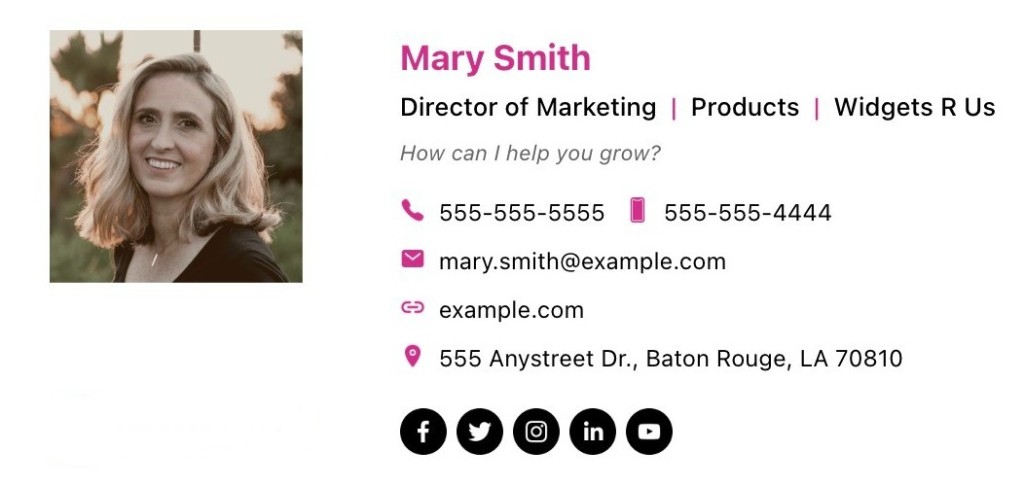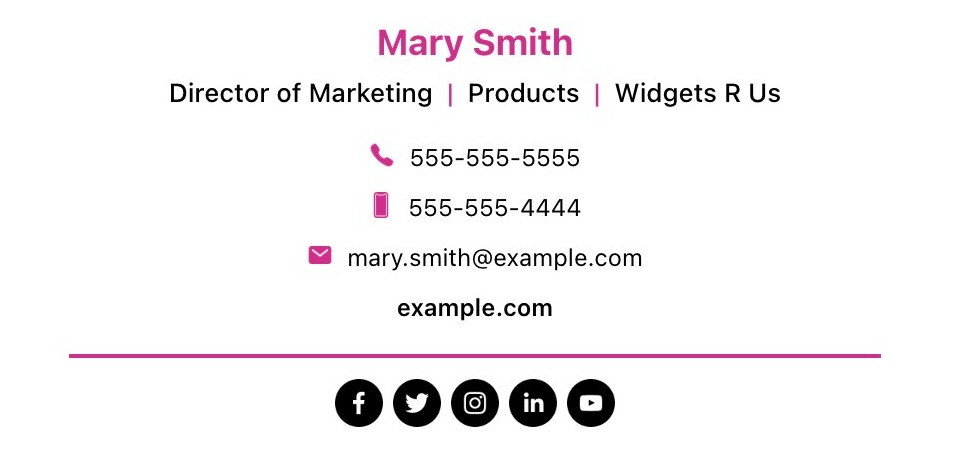While seemingly small and insignificant, your email signature is often one of the first pieces of marketing content potential customers will see. However, many small-business owners and creators overlook this miniscule-yet-mighty aspect of their online presence as they focus on larger tasks, like planning their website and managing their social media pages.
The little details matter when presenting yourself online. Small touches like an impactful email signature go a long way in building your identity and directing people where to go to learn more about you. It just takes a few minutes to create an email signature that will drive leads and lend a sense of cohesiveness to your online brand.
Best of all, it’s fairly simple to put together a professional-looking signature that matches your brand. You just need to put a little thought and care into it. I’ll teach you what to keep in mind as you create your email signature.

Identify your brand personality and visuals
Before you make your email signature, get a handle on your brand’s personality and visuals. Your brand will act as a foundation for your signature design choices.
If you work for an organization, look for your employer’s brand guide or ask your supervisor. You may also have specific guidelines to follow for your signature.
Meanwhile, if you’re a one-person endeavor, you’ll need to come up with your own brand guidelines.
Start with your personal brand’s voice and tone. Consider your ideal reader or customer and these two facts about them:
- How they like to be talked to: Does your audience want you to use professional language? What about a casual or friendly tone?
- How they talk about your industry: What language and tone does your usual email recipient use to talk about your industry or product? Go right to the source — your audience — to see what language resonates best with them.
For example, Bombas is a sock brand that donates clothes to people in need with each purpose. It keeps its audience’s compassion in mind in the language it uses, like in this Mother’s Day copy:

Once you understand your brand’s approach to language, translate it to email signature rules. If you have a casual tone, for example, you might keep your signature titles lowercase. Your voice and tone will also affect any messages you include in your signature, like notifications about confidentiality.
Then, establish some general rules about your visual identity. For your email signature, you’ll just need to think about colors and what picture of yourself to use. 99designs offers some factors to keep in mind as you establish your brand visuals.
But don’t be afraid to keep the “personal” aspect of personal branding when choosing your brand colors. For example, I like to use pink in my branding because it shows that I’m not afraid to share my favorite color and express my femininity. Bridge the gap between the vibes you want to give to clients and your authentic self.
Keep it concise and informative
Email signatures are there to accent your emails, not overwhelm them. Focus mainly on necessary information in your signature for a clean look.
The main elements to include in your email signature are:
- Your name and title
- Your company or brand name
- A link to your website
- Your business phone number (if you use one)
From there, you can add a few more details, but go for simplicity over comprehensiveness. Some popular options are:
- Your pronouns
- Links to your social media pages
- A notice about the confidentiality of your email
- A plug for your newsletter
- Your working hours
- A short inspirational quote
You can often use images or icons for links to save room. For example, my email signature has icons for my Twitter and LinkedIn pages that save room and add visual interest:

More info, arranged well, still not overwhelming
But what if you really need to include more information in your signature? As long as the information is organized well, it can still feel concise. Take a look at several example layouts that include quite a lot of information arranged in a clear, organized way.




Track your links
As with any piece of marketing content, your email signature should include trackable links. Why? This will allow you to measure the effectiveness of your design. You’ll be able to see which links people click on the most, and this can help you tweak your email signature in the future. You can use a link shortening service like cutt.ly, tinyurl.com, or bit.ly to both shorten your links and provide click tracking for those links.
Make it visually appealing
Speaking of visual interest, make sure your email signature looks aesthetically pleasing. Much like wearing the perfect button-up to an interview, using a good-looking email signature in an important email can make a lasting impression.
Keep the fonts in your signature simple and readable. In most situations, your email client’s default font will do the trick. You can also use a font from your website for consistency across your brand, but make sure it will load on most devices.
The same rule applies to images. Stick to a photo of yourself and a company logo at the most, plus a few icons if you need them. Images take up both precious space and loading time, so be deliberate in your choices.
Then, tie it all together with color. Use one or two of the brand colors you picked earlier in accents and icons. If you make any of your text a color besides black, run it through the WebAIM contrast checker to make sure it’s readable for everyone.

You can remove a lot of the guesswork from this process by using an email signature generator with templates. They come with pre-made layouts that you can plug your information into to get a copy-and-paste signature. Two good free options are HubSpot’s tool and Flamingo’s generator.
Optimize for mobile devices
People will be reading your emails on both desktop and mobile devices, so format your signature with both platforms in mind. Mobile-friendly email clients will do most of the work for you — you just need to make sure they translate your signature well to mobile.
Consider these factors as you build a signature for desktop and mobile:
- Images: Use small image sizes (less than 500 pixels wide and tall) to avoid crowding your signature on mobile. If possible, keep your images in JPG format, which loads faster than PNG format.
- Line breaks: Break up your text into multiple lines in your signature so they automatically adapt to mobile screen sizes. Try to avoid long sentences and paragraphs that will take up lots of space in a mobile signature.
- Links: Think of how easy the links in your signature will be to click on mobile. A good rule of thumb is to use one link per line, except for when you can organize them with icons.
Test and refine
Once you finish creating your email signature, test it across different email clients and devices to make sure it looks and works correctly for everyone who sees it.
This process can be a solo or team effort. Start by sending yourself an email and looking at your signature on every device and email client you own. You can also send one to someone you trust if they have different devices and clients to check with.
Pay attention to these elements as you evaluate your signature on each device and client:
- Layout: Does your signature have a similar layout in all of its versions? If not, do those different versions still look professional?
- Links: Do all the links in your signature work? Can you click on them easily?
- Images: Do your signature images look good on all devices? Do they load quickly?
- Legibility: Can you read all text and see all images clearly on all devices and clients?
After you first share your email signature with the world, update it regularly when you have any changes in your professional life. Add, edit, and remove links as your online presence changes. Keep your headshot, logo, and any other images current with your brand as well.
Tighten up your personal brand
Spiffing up your email signature is just one way you can improve your personal brand online. If you’re invested in revamping your online presence and don’t mind putting in the work, focus next on your personal website, especially the about me page.
Take the guidelines you established for your brand at the beginning of this blog post and apply them to your website. Then, make sure your about page tells your story and connects you with your visitors.
Want more tips? Get new post notifications emailed to you.

